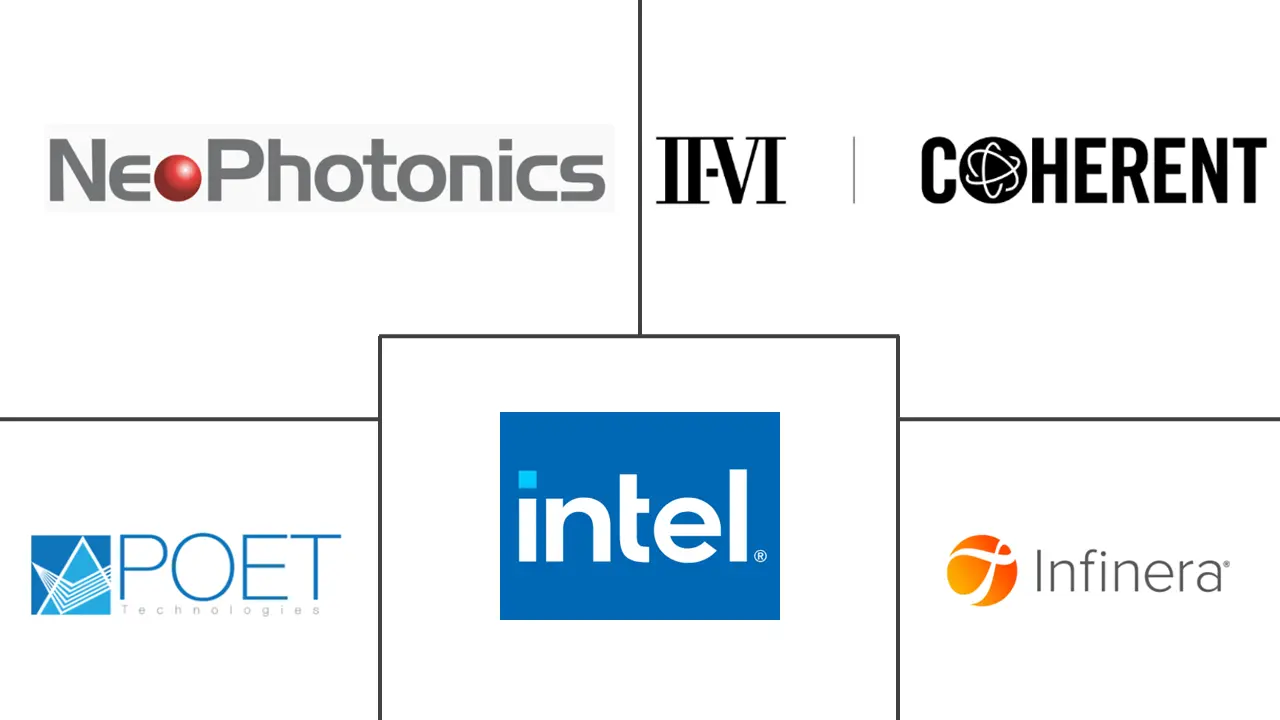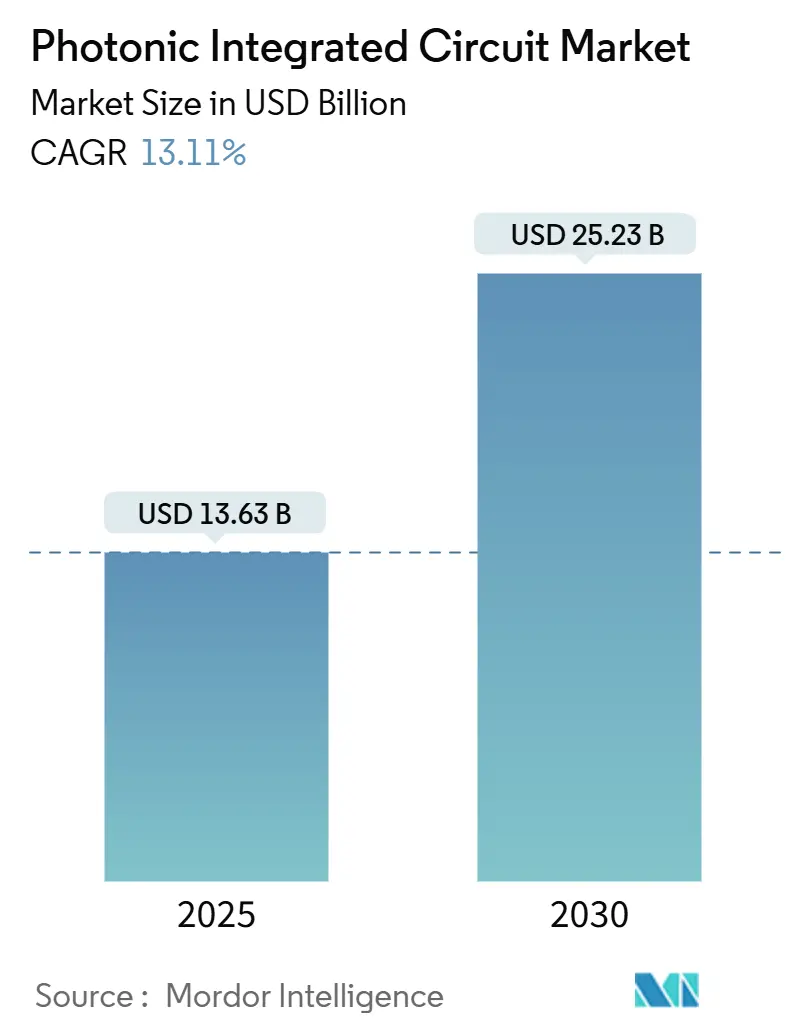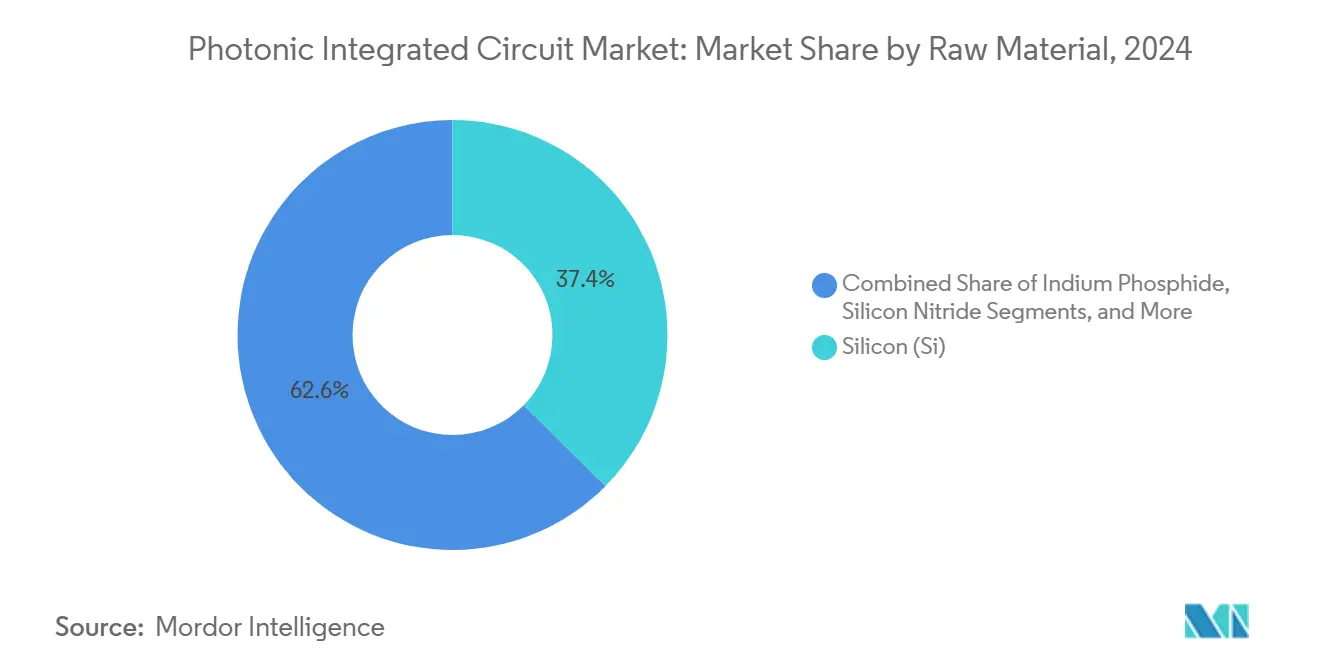Photonic Integrated Circuit Market Size and Share
Photonic Integrated Circuit Market Analysis by Mordor Intelligence
The photonic integrated circuit market size stood at USD 13.63 billion in 2025 and is projected to reach USD 25.23 billion by 2030, reflecting a 13.11% CAGR. This expansion mirrored the shift from experimental silicon photonics toward production-scale deployment in data centers, telecom networks, and early quantum systems, as rising AI workloads exposed the bandwidth and energy limits of copper interconnects.[1]Coherent Corp., “Silicon Photonics-Based 1.6 T Transceiver Modules,” coherent.com Commercial momentum benefited from cost advantages gained by leveraging established CMOS fabs, a vibrant venture capital pipeline, and growing government incentives to localize advanced photonic manufacturing. Meanwhile, rapid progress in co-packaged optics, thin-film lithium niobate modulators, and heterogeneous InP/silicon laser integration widened the performance gap with legacy optics. Intensifying supply-chain risks around gallium and germanium highlighted the strategic value of diversified materials platforms and regional foundry footprints.
Key Report Takeaways
- By raw material, silicon led with 37.4% revenue share in 2024, while silicon nitride registered the fastest 15.4% CAGR through 2030.
- By component, lasers held 26.3% of the 2024 revenue pool; optical switch matrices advanced at the highest 14.1% CAGR.
- By integration process, hybrid integration commanded a 59.7% share in 2024, whereas monolithic approaches accelerated at an 18.2% CAGR.
- By application, telecommunications contributed 45.5% of 2024 spending, yet data-center interconnects expanded most rapidly with a 19.6% CAGR.
- By end user, telecom service providers controlled 40.5% of 2024 demand; automotive and mobility OEMs grew the quickest at 20.3% CAGR.
- By geography, North America captured 35.4% of 2024 sales, while Asia-Pacific recorded the sharpest 16.5% CAGR.
Global Photonic Integrated Circuit Market Trends and Insights
Drivers Impact Analysis
| Driver | (~) % Impact on CAGR Forecast | Geographic Relevance | Impact Timeline |
|---|---|---|---|
| Silicon-Photonics Adoption in >400G Data-Center Transceivers (North America) | +3.2% | North America, with spillover to Europe and Asia-Pacific | Medium term (2-4 years) |
| EU Pilot-Line Funding Catalysing Local PIC Foundries | +1.8% | Europe, with technology transfer to allied regions | Long term (≥ 4 years) |
| PIC-Enabled Coherent 5G Backhaul Roll-outs (Asia) | +2.1% | Asia-Pacific core, expansion to the Middle East and Africa | Medium term (2-4 years) |
| Solid-State LiDAR Cost Downs in Autonomous Vehicles | +1.9% | Global, with early adoption in North America and Europe | Long term (≥ 4 years) |
| Venture Capital for Quantum-Interconnect PICs | +1.4% | North America and Europe, and emerging in Asia-Pacific | Long term (≥ 4 years) |
| Lab-on-Chip Photonic Diagnostics for Rapid Testing | +1.1% | Global, with accelerated adoption in developed markets | Medium term (2-4 years) |
Source: Mordor Intelligence
Silicon-Photonics Adoption in >400 G Data-Center Transceivers
North American hyperscale operators transitioned to 400 G and 800 G optical links to curb latency and power in AI clusters. Coherent Corp demonstrated a 1.6 T-DR8 module that cut energy per bit by more than 20% versus conventional pluggables. NVIDIA’s Spectrum-X switch roadmap adopted co-packaged optics that delivered 30% power savings and 1.6 Tb/s port speeds. Such architectures integrate photonic engines beside switch ASICs, eliminating electrical ingress losses and setting a volume pathway through established 300 mm CMOS lines. Growing demand for multi-rack GPU fabrics positions silicon photonics as an indispensable element of next-generation AI infrastructure.
EU Pilot-Line Funding Catalysing Local PIC Foundries
The EUR 380 million (USD 447.30 million) Chips JU award to the PIXEurope consortium underpinned Europe’s bid for photonic sovereignty.[2]ICFO, “PIXEurope Consortium to Lead Advanced PIC Pilot Line,” icfo.eu Pilot lines in Eindhoven and Enschede will offer open-access silicon and silicon-nitride runs, enabling SMEs to prototype without owning fabs. Projects such as photonixFAB focus on heterogeneous laser attachment at wafer scale, positioning Europe to meet local telecom and automotive demand when volume ramps after 2026. The initiative contrasts with vertically integrated US and Asian peers, promising a distributed, resilient supply chain.
PIC-Enabled Coherent 5G Backhaul Roll-outs
Asia-Pacific operators migrated from IM-DD links to coherent optics to support dense 5G macro sites. A 36.4 Gb/s bidirectional optical wireless prototype achieved long reach without regeneration. Japan committed USD 305 million to partner with Intel and SK Hynix on low-power photonic semiconductors targeted at mobile backhaul. China launched a thin-film lithium-niobate pilot line in Shanghai to secure a domestic supply for 6G roll-outs. Coherent optics lower total cost by eliminating intermediate O-E-O stages and reducing tower count in urban footprints.
Solid-State LiDAR Cost Downs in Autonomous Vehicles
Automotive OEMs pushed LiDAR prices below USD 1,500 when Voyant Photonics introduced an FMCW chip-scale sensor with 200 m range. Photonic phased arrays on silicon-nitride cores achieved 17°–40° beam steering without moving parts. The integration curtailed mechanical wear, improved assembly yields, and unlocked volume economics for advanced driver assistance systems. As cost barriers fell, Tier-1 suppliers embedded solid-state LiDAR in mass-segment platforms, spurring the photonic integrated circuit market across automotive supply chains.
Restraints Impact Analysis
| Restraint | (~) % Impact on CAGR Forecast | Geographic Relevance | Impact Timeline |
|---|---|---|---|
| Wafer-Scale Yield Challenges for InP PICs | -2.1% | Global, with acute impact in North America and Europe | Short term (≤ 2 years) |
| Fragmented EDA Toolchain Prolongs Design Cycles | -1.8% | Global, affecting all regions with PIC development | Medium term (2-4 years) |
| On-Chip Laser Thermal-Management Limitations | -1.3% | Global, particularly in high-performance applications | Medium term (2-4 years) |
| Concentrated Foundry Supply and Geopolitical Exposure | -1.9% | Global, with the highest risk in Asia-Pacific dependent regions | Long term (≥ 4 years) |
Source: Mordor Intelligence
Wafer-Scale Yield Challenges for InP PICs
Scaling InP wafers beyond 4 inches, strained defect control, and pushing up the cost per die. Coherent Corp’s six-inch line quadrupled theoretical die count yet required new epitaxy and metrology processes to maintain yield. Fraunhofer ISE demonstrated InP-on-GaAs substrates that cut cost by 80% and opened a roadmap to eight-inch scaling. Persistent yield drag continued to limit InP competitiveness in cost-sensitive applications, dampening near-term growth.
Fragmented EDA Toolchain Prolonging Design Cycles
Photonic designers relied on disparate simulation, layout, and verification tools lacking the maturity of electronic EDA suites. The 2024 Integrated Photonic Systems Roadmap flagged incomplete PDK coverage and low software interoperability as critical bottlenecks. OpenLight’s addition of PH18DA support in GDSFactory+ improved workflow continuity yet fell short of a fully unified environment. Longer development cycles slowed product introductions and raised R&D cost thresholds for new entrants.
Segment Analysis
By Raw Material: Silicon Dominance Faces Specialized Challenges
The photonic integrated circuit market size associated with raw-material sales reached USD 4.93 billion in 2025, and silicon retained 37.4% of the photonic integrated circuit market share in 2024. A broad installed CMOS base sustained its lead for passive waveguides and cost-critical datacom parts. Yet silicon nitride deliveries rose at a 15.4% CAGR thanks to low propagation loss and wide transparency that suited lab-on-chip and quantum photonics. Indium phosphide stayed essential for high-power lasers, while gallium arsenide gained traction through heterogeneous laser bonding that simplified silicon light-source integration.
Competition between scalability and performance shaped vendor roadmaps. Healthcare startups selected silicon-nitride biocompatibility for point-of-care diagnostics, whereas long-haul telecom vendors adhered to InP modulators for 140 Gbaud links. HyperLight’s USD 37 million raise to advance thin-film lithium-niobate modulators highlighted renewed interest in electro-optic champions. Increasing multilayer wafer stacking signalled a future where mixed materials co-reside on a single reticle, blurring traditional platform boundaries.
Note: Segment shares of all individual segments available upon report purchase
By Component: Laser Integration Drives Innovation
Component revenue surpassed USD 3 billion in 2025, with lasers accounting for 26.3% that year. Optical switch matrices outpaced all other devices at a 14.1% CAGR, reflecting demand for fully reconfigurable fabrics inside AI data-center clusters. Lumentum’s 400 Gb/s-per-lane electro-absorption modulated laser exemplified cresting performance benchmarks.
Integrated light generation remained the linchpin of total cost. Foundries coupled InP or GaAs gain media onto silicon to curtail external laser packaging, but thermal and yield issues added complexity. Photodetectors and modulators benefited from thin-film lithium-niobate architectures that combined ≥ 100 GHz bandwidth with sub-1 V drive efficiency. Variable optical attenuators and wavelength demultiplexers matured, yet rising channel counts spurred miniaturized array implementations.
By Integration Process: Monolithic Gains Momentum
Hybrid flows held 59.7% revenue in 2024 as vendors stitched III-V lasers onto silicon transceivers through flip-chip or wafer-bond technologies. Monolithic integration expanded at 18.2% CAGR once foundry yields approached electronic standards and thermal crosstalk models reached < 0.5 pm error. Programmable photonic engines relying on thousands of thermo-optic phase shifters prompted new on-chip cooling topologies.
Module-based approaches remained relevant to aerospace and defense, where qualification cycles favored discrete assemblies. For mainstream cloud operators, co-packaged optics steered demand toward silicon photonic engines merged with switch ASICs in a single substrate, shrinking BOM and power budgets. The Tower–Alcyon collaboration illustrated foundry-design synergies that nudged high-volume nodes closer to fully integrated photonic-electronic SoCs.
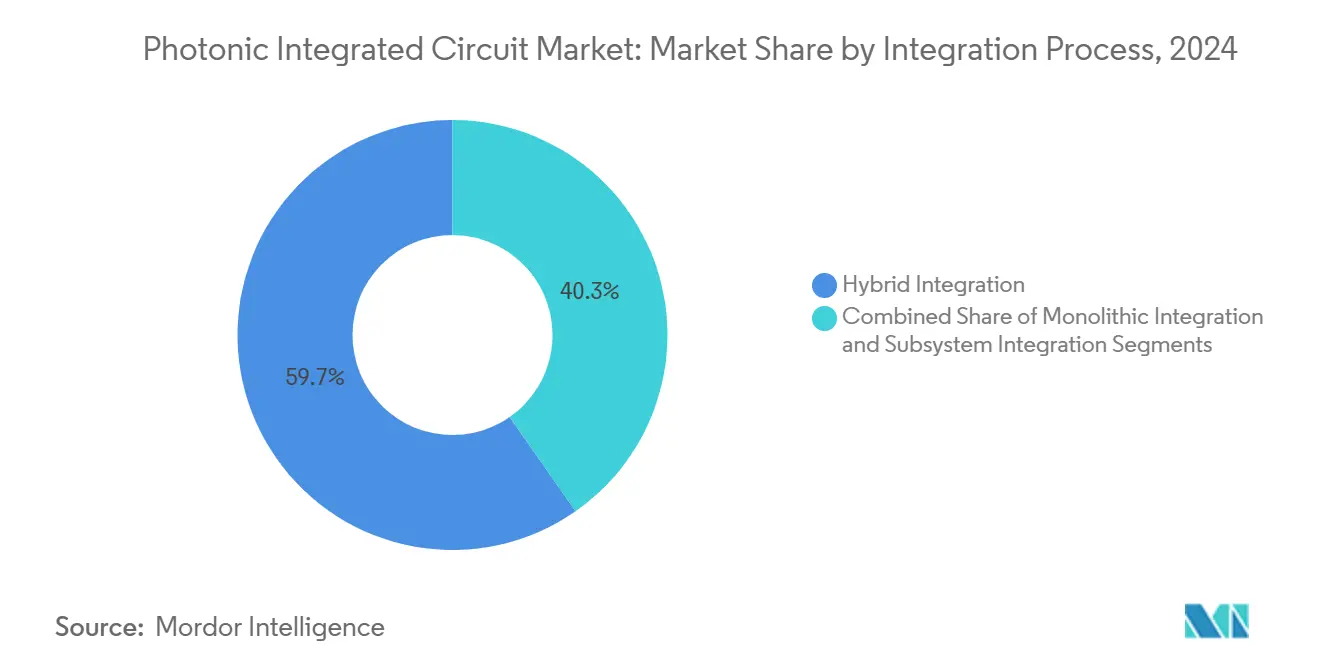
Note: Segment shares of all individual segments available upon report purchase
By Application: Data Centers Overtake Traditional Telecom
Global application spending crossed USD 5.5 billion in 2025. Telecommunications still provided 45.5% of 2024 revenue, but data-center interconnects advanced with a 19.6% CAGR and overtook telecom by 2029 as AI inference farms demanded petabit-scale fabrics. Biomedical optics adopted integrated spectrometers with 92 dB sensitivity at 55 kHz A-scan rates, supporting low-cost OCT imaging.
LiDAR and optical-sensor deployments jumped in automotive autonomy, while quantum-computing pilots used on-chip photon-number-resolving detectors to inch toward fault-tolerance. Test-and-measurement firms captured steady growth by servicing high-channel-count module validation. The expanding spectrum of use cases underlined the versatility of photonic platforms and insulated suppliers from cyclical telecom spending.
By End-User Industry: Automotive Acceleration Reshapes Demand
Telecom operators commanded 40.5% of 2024 demand, driven by metro coherent upgrades, yet automotive OEM uptake grew 20.3% annually as chip-scale LiDAR crossed cost thresholds for L2+ autonomy. Cloud providers ordered co-packaged optics in anticipation of GPU cluster scaling to millions of accelerators by decade-end.
Healthcare device makers leveraged silicon-nitride biosensors for rapid testing, while industrial firms integrated photonic probes for inline quality monitoring. Defense buyers prioritized ruggedized photonic links immune to EMI, sustaining a premium niche. The broadening customer mix diversified revenue streams and mitigated exposure to single-sector slowdowns.
Geography Analysis
North America generated the largest regional revenue share in 2024, of 35.4% of global sales 2024. Massive hyperscale data centers and CHIPS-Act incentives drew over USD 700 million of new silicon-photonics capex to Malta, New York.[3]Optics.org, “GlobalFoundries to Create New Silicon Photonics Facility,” optics.org Venture rounds for quantum and AI photonics, such as Lightsynq’s USD 18 million seed, fortified a vibrant start-up pipeline. However, reliance on Chinese gallium and germanium exposed material price shocks that climbed 75%–250% after 2024 export controls.
Asia-Pacific posted the fastest 16.5% CAGR as policymakers targeted photonic self-reliance. China subsidized CNY 8.2 billion (USD 1.15 billion) for integrated laser-silicon programs. Japan invested USD 305 million with Intel for optical semiconductors that cut data-center power use. Regional fabs produced six-inch thin-film lithium-niobate wafers that closed earlier Western technology gaps.
Europe combined open-access foundries with targeted M&A to sustain a 6.5% manufacturing CAGR from 2019-2024. The photonic integrated circuit market size for Europe was USD 3.02 billion in 2025. Sivers Photonics collaborated on narrow-linewidth tunable lasers to serve coherent modules, while Nokia’s USD 2.3 billion Infinera deal consolidated continental optical competence. The region’s emphasis on sovereignty and SME enablement diversified global supply and reduced overdependence on single-node manufacturing geographies.
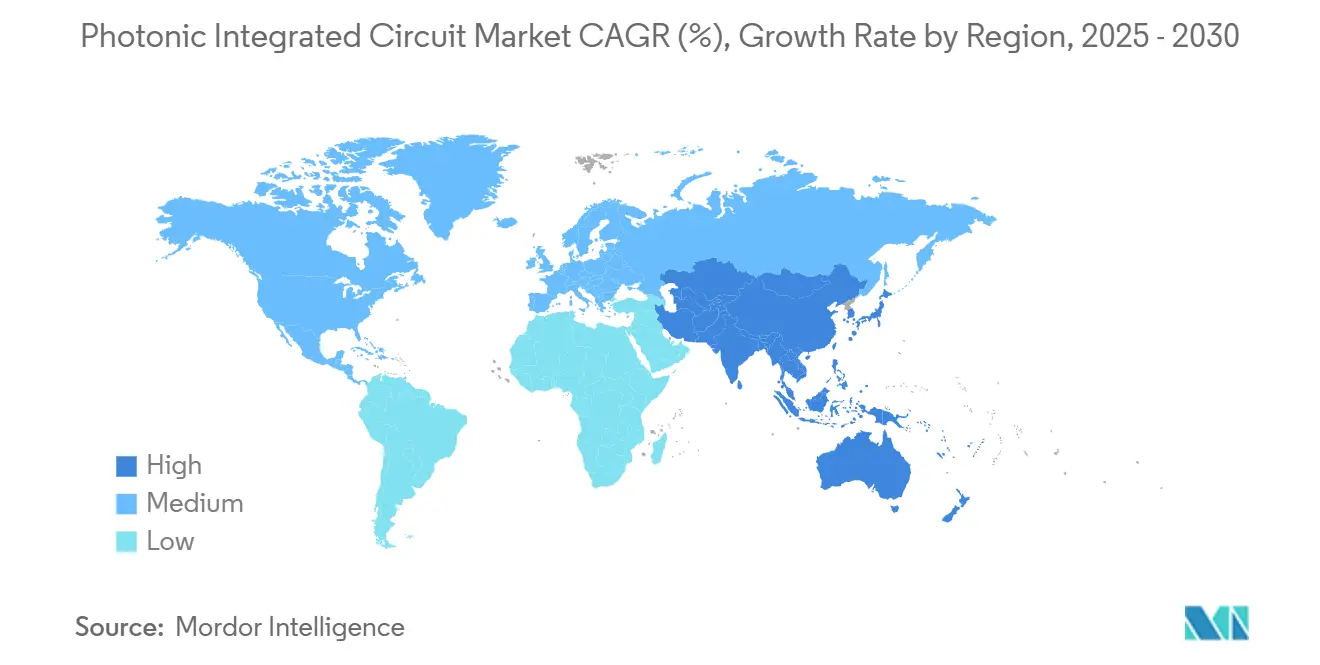
Competitive Landscape
The photonic integrated circuit market exhibited moderate fragmentation in 2025. Legacy optical-networking vendors such as Infinera, Lumentum, and Ciena leveraged decades of system know-how, whereas silicon photonics specialists like Intel, Lightmatter, and Celestial AI exploited CMOS economies of scale for AI workloads. Semiconductor leaders, including AMD, are vertically integrating optics via acquisitions such as Enosemi to accelerate co-packaged offerings.[4]AMD, “AMD Acquires Enosemi,” amd.com
Technology differentiation hinged on light-source integration, thermal-management IP, and design-automation depth. Coherent Corp spanned InP epitaxy to finished modules, while open-access foundries allowed fabless entrants to prototype rapidly. Quantum photonics, point-of-care diagnostics, and automotive LiDAR remained white spaces where nimble start-ups could secure early leadership. Strategic alliances, for instance between OpenLight and Jabil, shortened time-to-package cycles for AI and LiDAR applications. Patent activity around thermal crosstalk compensation and wafer-level heterogeneous bonding intensified as firms sought defensible advantages.
M&A momentum continued: IonQ bought Lightsynq to integrate quantum interconnect IP. Teradyne agreed to acquire Quantifi Photonics for wafer-scale PIC test capability. Such deals underscored the convergence of photonics with high-performance computing, test, and quantum sectors, reshaping the competitive contour through 2030.
Photonic Integrated Circuit Industry Leaders
-
NeoPhotonics Corporation
-
POET Technologies Inc
-
II-VI Incorporated
-
Infinera Corporation
-
Intel Corporation
- *Disclaimer: Major Players sorted in no particular order
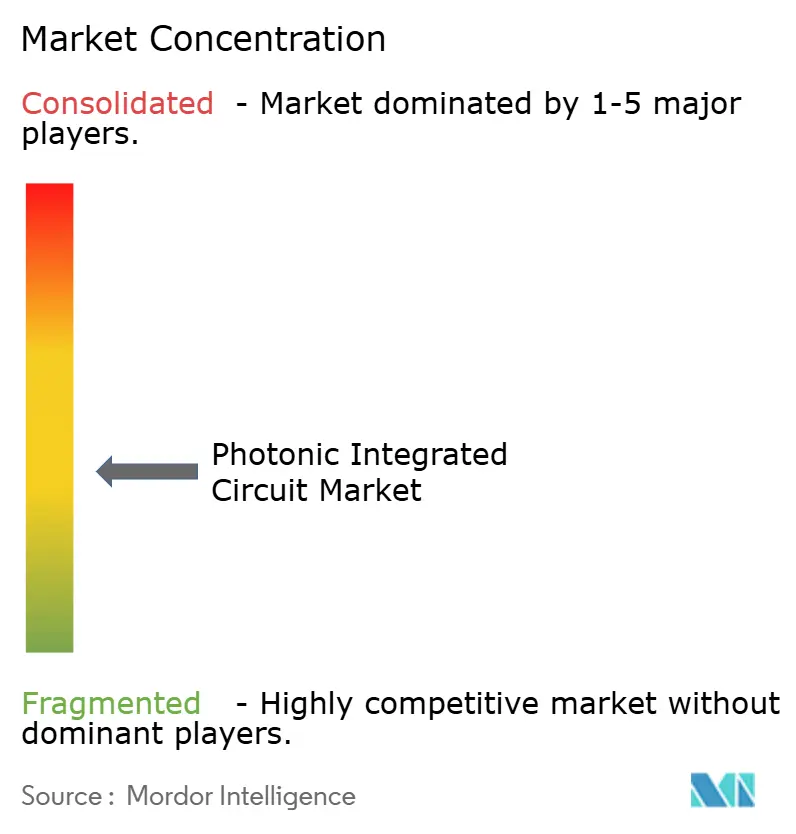
Recent Industry Developments
- June 2025: IonQ completed the acquisition of Lightsynq Technologies, adding more than 20 patents related to quantum memory and photonic interconnects.
- May 2025: AMD acquired Enosemi to speed co-packaged optics innovation for AI accelerators.
- March 2025: Coherent Corp released 2 × 400G-FR4 Lite silicon-photonics transceivers targeting AI data centers.
- March 2025: NVIDIA unveiled Spectrum-X and Quantum-X photonic switches delivering 1.6 Tb/s ports in partnership with Lumentum and Coherent.
Global Photonic Integrated Circuit Market Report Scope
A microchip contains two or more optical components forming a working circuit, which is sometimes referred to as an Integrated Photonics Circuit. This system is capable of detecting, generating, transporting, and processing.
The scope of the study covers photonic ICs, their growth and restricting factors, and the increased demand across various applications. The study also briefly analyzes the impact of macroeconomic trends on the market. The concept of the photonic integrated circuit is similar to electronic integrated circuits.
The photonic integrated circuit market is segmented by type of raw material (iii-v material, lithium niobate, silica-on-silicon, and other raw materials), integration process (hybrid and monolithic), application (telecommunications, biomedical, data centers, and other applications [optical sensors[LiDAR], and metrology]), and geography (North America, Europe, Asia Pacific and the rest of the World). The Market Size and Forecasts are Provided in Terms of Value in USD for all the Above Segments.
| By Raw Material | Indium Phosphide (InP) | |||
| Silicon (Si) | ||||
| Silicon Nitride (SiN) | ||||
| Gallium Arsenide (GaAs) | ||||
| Lithium Niobate (LiNbO₃) | ||||
| Silica-on-Silicon | ||||
| Other Materials (Polymer, PLC, etc.) | ||||
| By Component | Lasers | |||
| Modulators | ||||
| Photodetectors | ||||
| Filters | ||||
| Switches | ||||
| Amplifiers | ||||
| Multiplexers and Demultiplexers | ||||
| Attenuators and VOA | ||||
| Other Components | ||||
| By Integration Process | Hybrid Integration | |||
| Monolithic Integration | ||||
| Module-based/Subsystem Integration | ||||
| By Application | Telecommunications (Long-haul and Metro) | |||
| Data Centers (Short-Reach and HPC Interconnects) | ||||
| Biomedical and Life-Sciences | ||||
| Optical Sensors and LiDAR | ||||
| Metrology and Test/Measurement | ||||
| Quantum Computing and Quantum Photonics | ||||
| By End-user Industry | Telecom Service Providers | |||
| Cloud and Hyperscale Data-Center Operators | ||||
| Healthcare and Diagnostics Companies | ||||
| Automotive and Mobility OEMs | ||||
| Industrial and Manufacturing | ||||
| Defense and Aerospace | ||||
| Research and Academia | ||||
| By Geography | North America | United States | ||
| Canada | ||||
| Mexico | ||||
| Europe | Germany | |||
| France | ||||
| United Kingdom | ||||
| Nordics | ||||
| Rest of Europe | ||||
| Asia-Pacific | China | |||
| Taiwan | ||||
| South Korea | ||||
| Japan | ||||
| India | ||||
| Rest of Asia-Pacific | ||||
| South America | Brazil | |||
| Mexico | ||||
| Argentina | ||||
| Rest of South America | ||||
| Middle East and Africa | Middle East | Saudi Arabia | ||
| United Arab Emirates | ||||
| Turkey | ||||
| Rest of Middle East | ||||
| Africa | South Africa | |||
| Rest of Africa | ||||
| Indium Phosphide (InP) |
| Silicon (Si) |
| Silicon Nitride (SiN) |
| Gallium Arsenide (GaAs) |
| Lithium Niobate (LiNbO₃) |
| Silica-on-Silicon |
| Other Materials (Polymer, PLC, etc.) |
| Lasers |
| Modulators |
| Photodetectors |
| Filters |
| Switches |
| Amplifiers |
| Multiplexers and Demultiplexers |
| Attenuators and VOA |
| Other Components |
| Hybrid Integration |
| Monolithic Integration |
| Module-based/Subsystem Integration |
| Telecommunications (Long-haul and Metro) |
| Data Centers (Short-Reach and HPC Interconnects) |
| Biomedical and Life-Sciences |
| Optical Sensors and LiDAR |
| Metrology and Test/Measurement |
| Quantum Computing and Quantum Photonics |
| Telecom Service Providers |
| Cloud and Hyperscale Data-Center Operators |
| Healthcare and Diagnostics Companies |
| Automotive and Mobility OEMs |
| Industrial and Manufacturing |
| Defense and Aerospace |
| Research and Academia |
| North America | United States | ||
| Canada | |||
| Mexico | |||
| Europe | Germany | ||
| France | |||
| United Kingdom | |||
| Nordics | |||
| Rest of Europe | |||
| Asia-Pacific | China | ||
| Taiwan | |||
| South Korea | |||
| Japan | |||
| India | |||
| Rest of Asia-Pacific | |||
| South America | Brazil | ||
| Mexico | |||
| Argentina | |||
| Rest of South America | |||
| Middle East and Africa | Middle East | Saudi Arabia | |
| United Arab Emirates | |||
| Turkey | |||
| Rest of Middle East | |||
| Africa | South Africa | ||
| Rest of Africa | |||
Key Questions Answered in the Report
What was the global photonic integrated circuit market size in 2025?
The photonic integrated circuit market size reached USD 13.63 billion in 2025 and is forecast to double by 2030 at a 13.11% CAGR.
Which material platform is growing the fastest?
Silicon nitride leads growth with a 15.4% CAGR through 2030, propelled by its low-loss waveguiding and suitability for linear and quantum photonics.
Why are data-center interconnects gaining momentum over telecom applications?
Exponential bandwidth needs from AI workloads drive data-center operators to adopt co-packaged optics and high-density photonic links, producing a 19.6% CAGR that surpasses telecom growth.
What restrains wider adoption of InP photonic integrated circuits?
Wafer-scale yield challenges raise cost per die, limiting competitiveness against silicon photonics despite InP’s superior modulation bandwidth.
Which region will grow the fastest through 2030?
Asia-Pacific is projected to expand at a 16.5% CAGR, backed by significant Chinese and Japanese investments in domestic photonic manufacturing.
How did recent acquisitions influence industry dynamics?
Deals such as AMD-Enosemi and IonQ-Lightsynq illustrate platform companies buying photonic IP to accelerate product roadmaps, tightening integration across compute and optical domains.
Page last updated on: July 4, 2025

